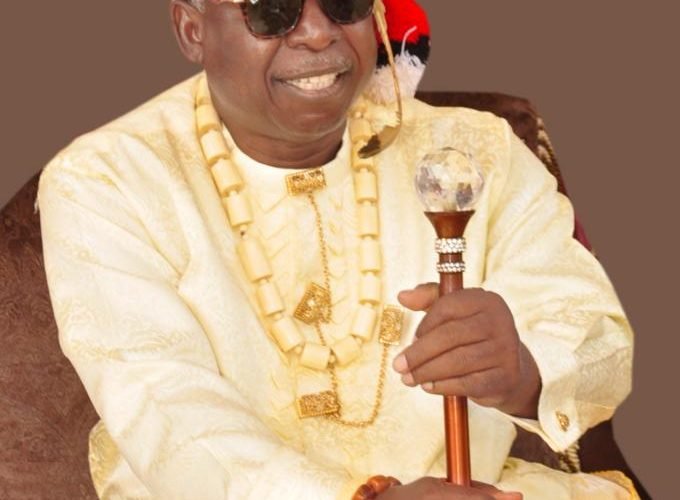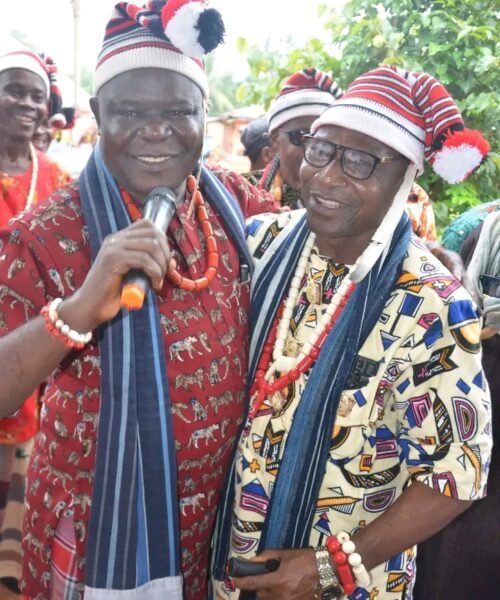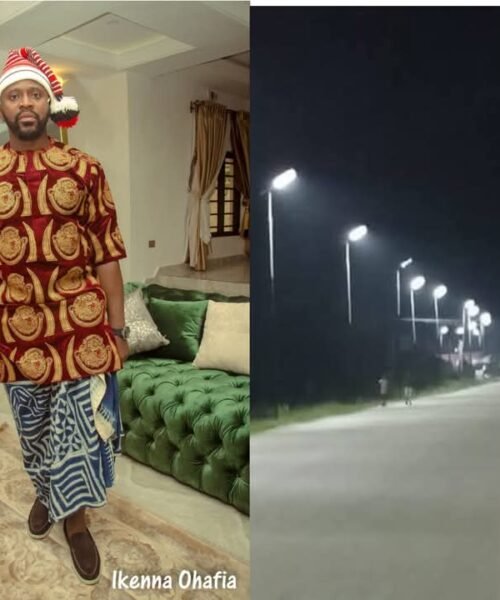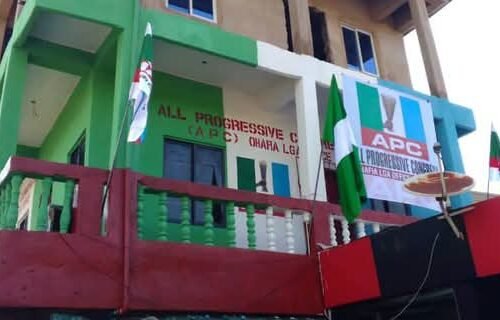ANNEX B
COUNCIL OF OHAFIA MONARCHS
(ONOKE NDE EZIEOGO OHAFIA)
THE UDUMEZE PALACE, ELU OHAFIA, ABIA STATE, NIGERIA.
PHONE: +234 803 8719671
E-Mail: udumezeohafiapalace@hotmail.com,
councilofohafiamonarchs@yahoo.com.
RE – AUTONOMOUS COMMUNITIES IN OHAFIA CLAN BY HIS HIGHNESS, IGWE OJIKE (MON).
OUR DEAR EZE IGWE OJIKE (MON),
The attention of the Council of Ohafia Monarchs has been drawn to your publication on the above subject.
We hail you for your love for the Ohafia nation, which in the first place informed your willingness to write this discourse on the “Autonomous Communities in Ohafia Clan.”
- Any unbiased person who reads your treatise will have no choice than to ask why you have decided to be a lone-ranger in your pursuit to wage war against Nde Ezieogo Ohafia. We will believe that it is not a case of a vaulting ambition, which usually over-leaps and falls on the other side?
One would have expected you to make use of your accumulated wealth of experience, your academic prowess, your exposure and your aculturisation and status to build the Ohafia values into a most admired system rather than tearing it apart and dismantling its world acclaimed values.
We are tempted to ask what your problem is? Please identify it, and we shall help you to find a solution. Is it the Royal Stool of Ohafia that you are after? … well, Eyes are watching.
We are not unmindful that you have left a legacy of dethroning Nde Ezieogo in Nkwebi to create room for yourself to occupy both the seat of the Ezieogo and that of the Autonomous Community Eze. A Latin adage says “Cave ne Cades” which translates “Take care that you do not fall”. Please do not extend this legacy of yours to Ohafia. In this light, we want to direct you to ensure the immediate reinstatement of Ezieogo of Nkwebi, in line with Ohafia tradition.
- HISTORICAL FACTS
Let us digress a bit into history and take cursory look at the structure of Traditional Administration in Ohafia before and after the advent of the British Colonialism in Ohafia.
i. Originally, Ohafia was made up of 25 villages known and addressed as (OFU RA ISO – TWENTY-FIVE) and later, Amankwu grew and developed to a village status. The whole of Ohafia agreed to and did accord a village status to Amankwu. Ohafia thus become 26 villages known and addressed as (OFU RA ISHI – TWENTY-SIX)
- ADMINISTRATION
i. The Village Council/Court:
The administration of each village in Ohafia is essentially on democratic line. The supreme control is lodged in the hands of the village council which is composed of the Ezieogo of the village together with heads of kindreds/families/compounds, and the Ezie Akpan. It is the Ezieogo who presides and announces the verdict of this court.
In summary, the Ezieogo in Council of the various villages are vested with the legislative, judiciary, customary and administrative functions in the community or village.
An unsatisfied litigant in the village council/court may appeal to the clan council/court in Elu Ohafia.
ii. The Clan Council/Court:
In addition to the village council, there exists the clan council made up of all the twenty-six village heads. The Ezieogo of Elu Ohafia who is the chairman of the Ohafia Council of Monarchs and the Udumeze of Ohafia presides. In his absence, the Eze Agba Ohafia, who id the Ezieogo of Amuma Ohafia presides.
This clan meeting of the Ohafia monarchs is called from time to time to discuss issues affecting the whole of Ohafia clan. They also sit to consider appeals emanating from the lower courts – the various village courts. Their verdicts are more often than not admissible in the law courts.
- Seemingly, you appear to have fallen in love with the Chieftaincy Edicts and Laws of Abia State in so much as they seem to favour your desires, but oblivious of the fact that such Chieftaincy Edicts and Laws has ‘code of conducts’, which means “a list of forbearances set out in the constitution of a community the breach of which by the incumbent Eze is punishable with suspension or deposition of the offending Eze”
- It may also interest you to note that the said law recognizes the existence of our cultural and traditional ways of life and by implication the Ezieogo-ship institutions, especially where there are not found to be repugnant to natural justice, equity and good conscience.
- Accordingly, your assertion that government does not recognize the institution of the Ezieogo is misconceived, misleading and mischievous and far from the truth. It is a sacrilege for anyone to discredit and abase the revered throne of our fore fathers the way you have done in your write up. We therefore, urge you to stop sowing seeds of discord that will destroy our custom, tradition, as well as the peace and harmony that we enjoy in Ohafia today.
- It is pertinent for you to note that the Chieftaincy Edict you have been quoting, provides that Autonomous Ezes should be addressed as His Highness (HH) and not His Royal Highness (a title specifically reserved for Royal Princes and Princesses). It will be stating the obvious to say that you HH Igwe Ojike do not have a drop of Royal blood in your veins.
The Ohafia system of traditional governance is an inheritance from our ancestors. Any attempt to banish it by you or someone else will be resisted because it is not in conflict with the constitutional governments of this country. Rather it is supportive.
- Ohafia has 26 autonomous and federated villages that demonstrate a true and typical example of Democratic Federalism.
And as you rightly observed, there cannot be two captains in one boat. The Ezieogo is the custodian of all traditional instruments of power and ruler-ship in Ohafia. He is the custodian of
(i). Custom, Tradition and Culture
(ii). Akpan
(iii). Ogele
(iv). Ikoro
(v). Otusi / Ofo;
(vi). The Ezieogo is also the only one traditionally authorized to wear double Eagle’s plumage
Please answer these questions if you can.
(i). In an Ohafia set up who decrees that there will be no market and it comes to pass?
(ii). Who decrees that nobody should go to farm and it comes to pass?
(iii). Who decided when new yam will be harvested and celebrated and it remains so?
(iv). If a land is needed for public or organizational use to whom does the applicant go?
(v). If an Autonomous Eze is to be selected and presented who presides, and who presents him?
(vi). If a citizen becomes a thorn in the flesh of the community and proves to be dangerously disposed, who gives order to bring the accused to the town square to prove himself innocent or otherwise?
For the avoidance of any doubt, the answer to the above questions is the Ezieogo – the Ohafia Monarch.
- Let us again go back into history for further clarification. During the colonial era, the British Colonial government created institutions that would enable them perform certain functions at the grass root level.
The Ezieogo was assigned the duty of the tax collector. This put the Ezieogo in a most unenviable position. He will get the butt of the government if he fails to collect the tax, and if he collects the tax, his people become disgruntled at being made to pay and being summoned to court for failure to pay. Later, other agents were used to collect taxes, but despite the fact that these agencies operated at the grassroot, the colonial masters were careful not to interfere with the traditional system of the people.
It is, in the light of the above that most communities in Ohafia decided to shield their Ezieogo from political and government interference, and thereby presented an alternative candidate to the Autonomous stool, who may be removed by the government’s whims and caprices.
These government agents were known as Warrant Chiefs. They operated all over Eastern Nigeria, but at no time did they challenge the authority or have conflict with the Obis, Ezes, Obongs, Ezieogos, etc. these Warrant Chiefs treaded the boundary line of power with caution. Furthermore, Ndi Ezieogo were recognized during the colonial era and that was why the white man went to the Ezieogo to request for a piece of land to build schools, churches, police stations, etc. they did not go to the Warrant Chiefs, just ass they do not go to the Autonomous Community Ezes today.
- Let us revisit pages 5 and 6 of your treatise.
Under group B (Realignment or Dismemberment)
Take note that the truncated Ebem-Oha Autonomous Community metamorphosed into
Ekelogo Autonomous Community – Ezelogo Ebem
Eziukwu Autonomous Community – Eziukwu Ebem
Ebem-Oha Autonomous Community
Comprising Mgbaga Ebem, Ihenta (Ibina), Ndi Amogu, Ndi Anyaorie, Ndi Okala
Despite this arrangement, be informed that what is called Ebem Ohafia still exists as a village in Ohafia, with Ezieogo Ukoha Kalu Ukaoha as the Ezieogo of Ebem Ohafia and the Eze of Ekelogo Autonomous Community.
Be informed also that Ebem Ohafia has a development Union known as Ebem Ohafia Development Union. It is not moribund as you claim. It remains the heart of all developments in Ebem Ohafia.
We would challenge you to mention one project in Ohafia carried out by an Autonomous Community Development Union. We are not talking of any contraption put together by you in Nkwebi to buy the soul of the people.
- FOR THE FUTURE – JUST TO KEEP THE RECORDS STRAIGHT.
Ohafia was swimming in the ocean of love, peace, unity and progress. Ohafia decided to build a secondary school, the Ohafia High School. Three Ohafia sons were selected to study in America in order to come back and run this school. Many villages that this scholarship award did not favour were not pleased. Some decided to send their own sons to the University both in Nigeria and abroad. Soon, the agitation to split Ohafia into four clans to accelerate development, began.
Ohafia came to be divided into 4 clans namely;
Isiama
Comprising Elu, Amaekpu, Okagwe, Nkwebi, Ndia Nku, Ndi Uduma Ukwu, Oboro, Ebem, Ihenta (Ibina), Ndi Amogu, Ndi Anyaorie and Ndi Okala.
Ania:
Comprising Akanu, Isiugwu, Abia, Ndi Uduma Awoke
Ohafor:
Comprisingf Asaga, Amuke, Eziafor, Ndi Ibe and Ndi Orieke.
Okamu:
Comprising Okon, Amuma, Amangwu and Ufiele
- About 1959 – 1960, during Nigeria Independence, Dr. M.I. Okpara became the Prime Minister (Premier) of Eastern Nigeria. He established the Eastern House of Chiefs to conform with what obtained in the North and West. Ohafia came to Elu for a candidate to occupy the position. The Ezieogo of Elu then was an illiterate and not suitable.
A school master at AggreyMemorial College Arochukwu who is from the Umua Lekwa Ruling Family in Elu Ohafia was presented.
Thus, HRM Eze Okon Agbai Olugu II became a second-class Chief in the Eastern Nigeria House of Chiefs and the Udumeze of Ohafia.
- About 1979, when Chief Onunaka Mbakwe Ph.d became the Governor of Imo State, he created Autonomous Communities. All the four clans in Ohafia became Autonomous Communities.
Additionally, Ebem-Oha Autonomous Community was carved out of Isiama Autonomous Community and Okon Aku from Okamu.
The New Autonomous Communities were six:
Isiama
Ania – now the newly created Amankwu had become a village in Ania.
Ohafor
Ebem-Oha
Okon-Aku and
Amaukwu – what is left of Okamu after carvingout Okon Aku.
Later, the following new Autonomous Communities emerged from these six Autonomous Communities.
Onwuwa Anyanwu
Nkwebi
Asaga Ukwu
Amaibe
Amangwu Anaga Uka
Eziafor Ukwu
Amaedo
Ekelogo
Eziukwu
- (i) That a person is ignorant of a phenomenon does not mean that the situation does not exist. May we refer to P8 section 9 of your write-up where you ignorantly averred that, and we quote, “The Ezieogo” as a nomenclature is foreign to Ohafia culture and tradition.” Unquote. You have displayed by this singular statement the degree by which you have distanced yourself from Ohafia history, custom, culture and tradition.
As far back as 1910 when the Church of Scotland Mission came to Ohafia, the Ezieogo of Elu Ohafia was Ezieogo Imaga Agwunsi. It was through him that all negotiations were carried out. Ohafia had the institution of Ezieogo long before the advent of the white man.
(ii). In 1960 when Nigeria became independent, Sir Francis Akanu Ibiam became the Governor of Eastern Nigeria and at that time, Nna Agbai Opia was the Ezieogo of Elu Ohafia. Sir Francis was not an Ezieogo then.
(iii). After many years as the governor, about six years, Sir Francis went to his home town, Unwana and become the Ezieogo. Do you see how misinformed you and some other Ezes are, when you aver that Ezieogo is foreign to Ohafia culture and tradition and that it was borrowed from Afikpo. Wherever people use Ezeogo in Ibo land, it is borrowed from Ohafia and not Ohafia borrowing Ezeogo from Afikpo as you erroneously upheld.
(iv). Read the British intelligence report on Ohafia (1927 – 1930) and you will see that Ezieogo institution existed before then and the white man was dealing with them.
- There are Autonomous Community Ezes who have decided to work in harmony with their Ezieogo. These Ezes are making progress in their various areas but those ones who are oppressive and want to exert a non-existent power on the Ezieogo have not had peace in their “Kingdom” and they will not, unless there is a change of heart.
We therefore advice that you, in particular, step down from your Olympian height. Dialogue with your Ezieogo and Nde Ezieogo to find ways of moving Ohafia forward for the good of Ohafia and humanity which is the reason why the State Government gave you a Staff of Office in the first place. Please return your Staff of Office to the State Government if you prefer war to peace. Also, note that the law that creates autonomous communities in Abia State, posit that the communities seeking autonomous status must have:
A School – (Secondary and Primary)
A daily market
A health centre/hospital
A major stream
More than one community/village.
Therefore, is Nkwebi qualified to be an autonomous community going by the law in Abia State?
(To be continued)







